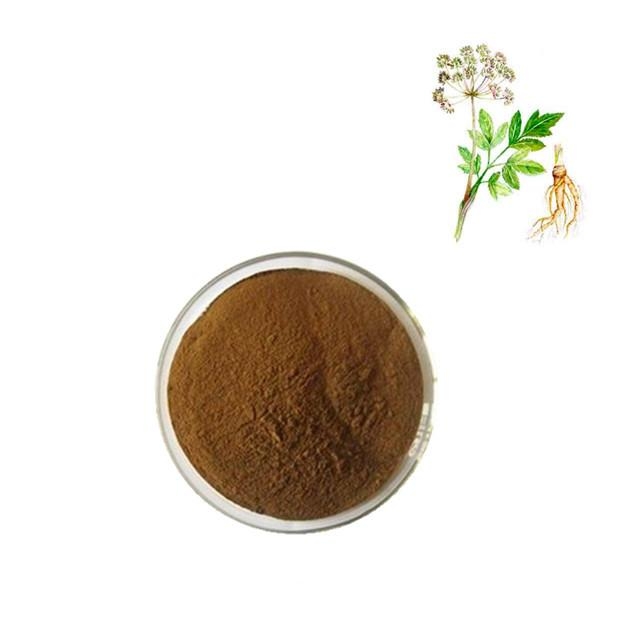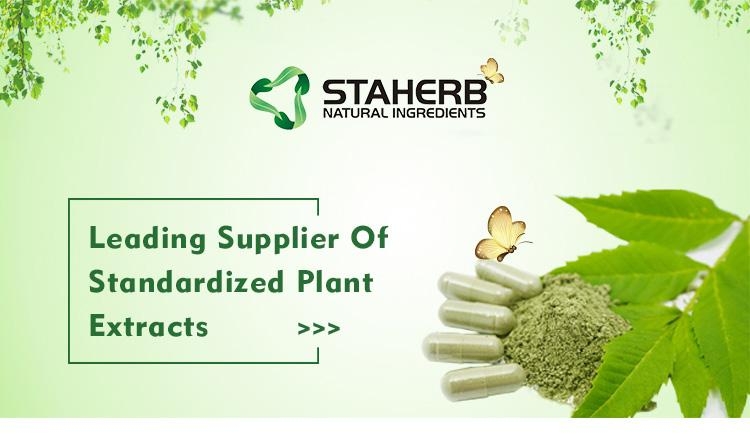Angelica extract Ligustilides1%-3%
Product Name: Angelica Extract/Angelica Root Extract
Part used: Root
Appearance: Brown fine powder
Specification: Ligustilides1%-3%
Test Method: HPLC
Color: Brown fine powder
About Angelica herb.
Angelica is an aromatic herb that grows in China, Korea, and Japan. The reputation of Angelica is second only to Ginseng and is considered the ultimate, all-purpose woman's tonic herb. Angelica is used for almost every gynecological
complaint from regulating the menstrual cycle to treating menopausal symptoms caused by hormonal changes.
Angelica is a good remedy for colds, coughs, pleurisy, wind, colic, rheumatism and diseases of the urinary organs,
and it is generally used as a stimulating expectorant, combined with other expectorants the action of which is
facilitated, and to a large extent diffused, through the whole of the pulmonary region. It is also a useful agent for
feverish conditions,acting as a diaphoretic.The dried root of Angelica sinensis is commonly known as Chinese
angelica and is widely used in Chinese traditional medicine for gynecological ailments, fatigue, mild anemia and
high blood pressure.
What is Angelica Extract?
Natural angelica sinensis extract - a traditional Chinese herbal Extract for the symptoms of PMS.In Asia, dong quai's
reputation is perhaps second only to ginseng. Predominantly regarded as a 'female' remedy,dong quai has been usedin such conditions as painful menstruation,and for menopausal symptoms.Scientific investigation has shown dongquaiproduces a balancing effect on estrogen activity and a tonic effect on the uterus, normalising uterine contractions.
Dong quai is generally quite safe. However, because it does contain photoreactive substances, overexposure to
sunlight should be avoided.
Functions of Angelica Extract
1. Curing heart-throb,megrim and injuries from falls and also enriching the blood.
2. Providing energy,vitality,and resistance to disease.
3. Treating anemia,boils,headaches,venous problems,low im-munity,and problems of peripheral blood flow.
4. Regulating female hormones,in the treatment of most menstrual and menopausal problems and in pregnancy and
delivery.
5. preventing spasms,relaxing vessels,and reducing blood clotting in peripheral vessels.
(6). Antioxidant and free radical scavenging.
Application of Angelica Extract
1.Chinese Angelica Sinensis Extract Powder are applied in pharmaceutical field, Salvianolic Acid Bis mainly used
as raw material for clearing heat, anti-inflammation, detumescence and increasing coronary flow.
2.Chinese Angelica Sinensis Extract Powder are applied in food additives, it owns the effect of antifatigue, anti-aging and nourishing brain.
3.Chinese Angelica Sinensis Extract Powder are applied in cosmetics field, it owns the effect of whitening, anti-aging,anti-wrinkle,anti-oxidant, activating skin Cells, making skin more tender and firm.
For more product inforamtion pls kindly contact email sales09@staherb.cn
References:
- 1.
Han Bok K, Byeong Ki L: Inhibition of osteoclast differentiation and bone resorption by rotenone, through down-regulation of RANKL-induced c-Fos and NFATc1 expression. Bone. 2010, 46: 724-731. 10.1016/j.bone.2009.10.042.
- 2.
Boyle WJ, Simonet WS, Lancey DL: Osteoclast differentiation and activation. Nature. 2003, 423: 337-342. 10.1038/nature01658.
- 3.
Arai F, Miyamoto T, Ohneda O, Inada T, Sudo T, Brasel K: Commitment and differentiation of osteoclast precursor cells by the sequential expression of c-Fms and receptor activator of nuclear factor kappaB (RANK) receptors. J Exp Med. 1999, 190: 1741-1754. 10.1084/jem.190.12.1741.
- 4.
Suda T, Takahashi N, Udagawa N, Jimi E, Gillespie MT, Martin TJ: Modulation of osteoclast differentiation and function by the new members of the tumor necrosis factor receptor and ligand families. Endocr Rev. 1999, 20: 345-357. 10.1210/edrv.20.3.0367.
- 5.
Kobayashi N, Kadono Y, Naito A, Matsumoto K, Yamamoto T, Tanaka S: Segregation of TRAF6-mediated signaling pathways clarifies its role in osteoclastogenesis. EMBO J. 2001, 20: 1271-1280. 10.1093/emboj/20.6.1271.
- 6.
Hotokezaka H, Sakai E, Kanaoka K, Saito K, Matsuo K, Kitaura H: U0126 and PD98059, specific inhibitors of MEK, accelerate differentiation of RAW264.7 cells into osteoclast-like cells. J Biol Chem. 2002, 277: 47366-47372. 10.1074/jbc.M208284200.
- 7.
Matsuo K, Galson DL, Zhao C, Peng L, Laplace C, Wang KZ: Nuclear factor of activated T-cells (NFAT) rescues osteoclastogenesis in precursors lacking c-Fos. J Biol Chem. 2004, 279: 26475-26480. 10.1074/jbc.M313973200.
- 8.
David JP, Sabapathy K, Hoffmann O, Idarraga MH, Wagner EF: JNK1 modulates osteoclastogenesis through both c-Jun phosphorylation-dependent and –independent mechanisms. J Cell Sci. 2002, 115: 4317-4325. 10.1242/jcs.00082.
- 9.
Lee SE, Woo KM, Kim SY, Kim HM, Kwack K, Lee ZH: The phosphatidylinositol 3-kinase, p38, and extracellular signal-regulated kinase pathways are involved in osteoclast differentiation. Bone. 2002, 30: 71-77.
- 10.
Takayanagi H, Kim S, Koga T, Nishina H, Isshiki M, Yoshida H: Induction and activation of the transcription factor NFATc1 (NFAT2) integrate RANKL signaling in terminal differentiation of osteoclasts. Dev Cell. 2002, 3: 889-901. 10.1016/S1534-5807(02)00369-6.
- 11.
Matsuo K, Owens JM, Tonko M, Elliott C, Chambers TJ, Wagner EF: Fos is a transcriptional target of c-Fos during osteoclast differentiation. Nat Genet. 2000, 24: 184-187. 10.1038/72855.
- 12.
Nakashima T, Takayanagi H: Osteoimmunology: cross talk between the immune and bone systems. J Clin Immunol. 2009, 29: 555-567. 10.1007/s10875-009-9316-6.
- 13.
Zhao Q, Wang X, Liu Y, He A, Jia R: NFATc1: function in osteoclasts. Int J Biochem Cell Biol. 2010, 42: 576-579. 10.1016/j.biocel.2009.12.018.
- 14.
Grigoriadis AE, Wang ZQ, Cecchini MG, Hofstetter W, Felix R, Fleisch HA: c-Fos: a key regulator of osteoclast-macrophage lineage determination and bone remodeling. Science. 1994, 266: 443-448. 10.1126/science.7939685.
- 15.
Su YW, Chiou WF, Chao SH: Ligustilide prevents LPS-induced iNOS expression in RAW 264.7 macrophages by preventing ROS production and down-regulating the MAPK, NF-κB and AP-1signaling pathways. Int Immuno Pharmacol. 2011, 11: 1166-1172. 10.1016/j.intimp.2011.03.014.
- 16.
Yang C, Niu S, Lifeng Y: The aqueous extract of Angelica sinensis, a popular Chinese herb, inhibits wear debris-Induced Inflammatory osteolysis in mice. J Surg Res. 2012, 176: 476-483. 10.1016/j.jss.2011.08.011.
- 17.
Wang H, Li W, Li J: The aqueous extract of a popular herbal nutrient supplement, Angelica sinensis, protects mice against lethal endotoxemia and sepsis. J Nutr. 2006, 136: 360-
- 18.
Kim K, Kim JH, Lee J, Jin HM, Lee SH, Fisher DE: Nuclear factor of activated T cells c1 induces osteoclast-associated receptor gene expression during tumor necrosis factor-related activation-induced cytokine mediated osteoclastogenesis. J Biol Chem. 2005, 280: 35209-35216. 10.1074/jbc.M505815200.
- 19.
Matsumoto M, Sudo T, Saito T, Osada H, Tsujimoto M: Involvement of p38 mitogen-activated protein kinase signaling pathway in osteoclastogenesis mediated by receptor activator of NF-kappa B ligand (RANKL). J Biol Chem. 2000, 275: 31155-31161. 10.1074/jbc.M001229200.
- 20.
Takayanagi H: Osteoimmunology. Nat Rev Immunol. 2007, 7: 292-304. 10.1038/nri2062.
- 21.
Iotsova V, Caamano J, Loy J, Yang Y, Lewin A, Bravo R: Osteopetrosis in mice lacking NF-kappaB1 and NF-kappaB2. Nat Med. 1997, 3: 1285-1289. 10.1038/nm1197-1285.
- 22.
Hayden MS, Ghosh S: Signaling to NF-κB. Genes Dev. 2004, 18: 2124-2195.
- 23.
Crotti TN, Flannery M, Walsh NC, Fleming JD, Goldring SR, McHugh KP: NFATc1 regulation of the human beta 3 integrin promoter in osteoclast differentiation. Gene. 2006, 372: 92-102.
- 24.
Kim Y, Sato K, Asagiri M, Morita I, Soma K, Takayanagi H: Contribution of nuclear factor of activated T cells c1 to the transcriptional control of immunoreceptor osteoclast-associated receptor but not triggering receptor expressed by myeloid cells-2 during osteoclastogenesis. J Biol Chem. 2005, 280: 32905-32913. 10.1074/
- 25.
Matsumoto M, Koqawa M, Wada S, Takayangi H, Tsujimoto M, Katayama S: Essential role of p38 mitogen-activated protein kinase in cathepsin K gene expression during osteoclastogenesis through association of NFATc1 and PU.1. J Biol Chem. 2004, 279: 45969-45979. 10.1074/jbc.M408795200.
- 26.
Ikeda F, Nishimura R, Matsubara T, Tanaka S, Inoue J, Reddy SV: Criticalroles of c-Jun signaling in regulation of NFAT family and RANKL-regulated osteoclast differentiation. J Clin Invest. 2004, 114: 475-484. 10.1172/JCI200419657.
- 27.
Wagner EF, Eferl R: Fos/AP-1 proteins in bone and the immune system. Immunol Rev. 2005, 208: 126-140. 10.1111/j.0105-2896.2005.00332.x.
- 28.
Mohamed S: Interleukin-10 inhibits RANKL-mediated expression of NFATc1 in part via suppression of c-Fos and c-Jun in RAW264.7 cells and mouse bone marrow cells. Bone. 2007, 41: 592-602. 10.1016/j.bone.2007.05.016.
-
Changsha Staherb Natural Ingredients Co.,ltd.
Address: Room.202, Buliding B8, Huanchuang Enterprise Square, High-tech Development Zone, Changsha, Hunan, China(410205)
Contact:Mary
Email: sales05@staherb.cn sales@staherb.cn
Tel :+86-(0)731-84213302 Fax:+86-(0)731-85953715
Website:www.staherb.cn
|
|



